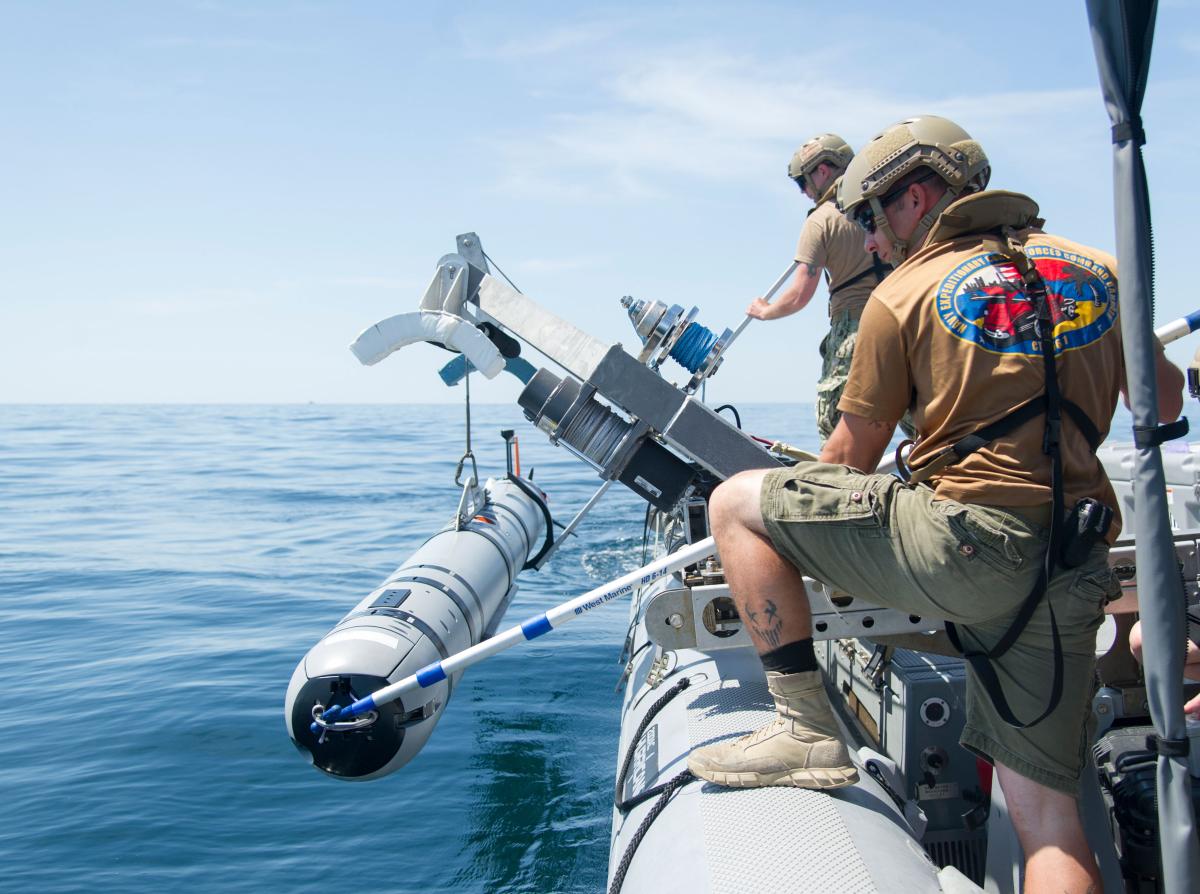To prepare for great power conflict, both the mine countermeasures (MCM) force and the supported force must train to overcome realistic mine threats. Too often, the Navy treats MCM as though mine warfare happens in a vacuum. This degrades training to the detriment of both the MCM force and the supported force. At the operational level, MCM enables units to safely transit from point A to point B. To borrow a football analogy, the MCM force is the offensive line that allows the rest of the offense to execute its mission. If the offensive line does not practice with the rest of the offense, it will show on game day.
Separating many MCM exercises from surface fleet and amphibious force exercises promotes a divide between MCM and the larger mission. The Navy must fully incorporate MCM into training exercises; not merely simulate a training delay for the pretend MCM force to clear mines. Integrating MCM into these larger exercises may disrupt the fleet’s battle rhythm, but that is exactly what mines would do in conflict. Surface ships and amphibious forces cannot always sidestep mines; mining has and will continue to affect operational decisions.
In addition to integrating with supported units, MCM units must train to operate in conditions mirroring great power conflict. How would MCM occur in contested waters with degraded GPS? How will MCM forces prioritize clearance when operating with a no-fail timeline? MCM training must include some of these curveball, but entirely plausible, great power conflict scenarios. Right now, the Navy evaluates MCM forces solely on their ability to execute MCM under ideal conditions. Controlling the exogenous variables standardizes training scenarios, which helps to evaluate and compare various MCM units. However, this training approach does not simulate reality and instills false confidence.
Restructure Expeditionary MCM Companies
Expeditionary MCM (ExMCM) companies, which consist of an unmanned underwater vehicle (UUV) platoon to launch and recover the Mk 18 UUVs, an analysis platoon to analyze the UUV data, and an explosive ordnance disposal (EOD) platoon to prosecute the mine-like contacts, provide a rapidly deployable, scalable solution for certain MCM operations. Integrating the full detect-to-engage sequence into one unit streamlines and expedites the MCM mission. ExMCM’s small footprint and subsequent ability to use a wide-range of support craft drastically reduces response times. Embarking an ExMCM company on a support craft is the 21st-century version of rigging trawlers and tugboats with minesweeping equipment.
However, the ExMCM command structure must adapt to maximize the company’s potential. The first restructuring should occur within the ExMCM company itself. The Navy sources each platoon within the ExMCM company from different commands. Sometimes the platoons are geographically separated prior to deployment, complicating ExMCM company command and control. To foster interoperability and unit cohesiveness, the Navy should structure the three platoons under the same parent command.
A second ExMCM restructuring should take place at the command level. Currently, each of the eight Navy EOD mobile units (EODMUs) commands one or two ExMCM companies. In addition to the ExMCM company, each EODMU also commands deployable platoons and shore-based detachments. These platoons and detachments primarily provide EOD support to ground units, carriers during flight operations, and naval installations to include ships in port. The administrative and logistics support required for the traditional Navy EOD mission vastly differs from the support required for the ExMCM mission. Consolidating the ExMCM companies under the umbrella of a single EODMU on each coast maximizes synergies between the ExMCM companies with respect to training, equipment, and personnel. The ExMCM EODMU can retain lessons learned by the ExMCM companies, preventing the ExMCM companies from having to independently relearn the same lessons.
During peacetime, the ExMCM EODMU will have greater bandwidth to advocate for sustained integration into units supported by ExMCM and into combined and joint training exercises, alleviating the problem of only training for MCM in a vacuum. During wartime, this structure would provide an experienced underwater MCM commander solely dedicated to the ExMCM mission. In addition, during great power conflict the supported force may require multiple ExMCM companies. The ExMCM EODMU can better allocate forces during this scenario to achieve unity of effort.
Lastly, ExMCM companies should integrate with supported units by deploying as part of a carrier strike group (CSG) or expeditionary strike group (ESG). Deploying the ExMCM companies with carrier strike groups or expeditionary strike groups promotes peacetime interoperability. The ExMCM company would gain experience operating with the supported units, and carrier strike groups and expeditionary strike groups would better understand the capabilities and limitations of the deployed ExMCM company. This deployment structure better aligns ExMCM companies with MCM’s overarching mission: supporting naval and amphibious forces. Restructuring ExMCM at both the company level and command level and deploying ExMCM companies with carrier strike groups and expeditionary strike groups mitigates issues with lack of realism and interoperability that plague the current MCM force.
Despite its benefits, the Navy must guard against overreliance on ExMCM. What makes the ExMCM company adaptable—operating in small boats from a wide variety of support craft—is also its Achilles’ heel. ExMCM assets are extremely susceptible to sea state, weather, and current. Data analysts cannot always identify certain mines on the sonar data, and EOD divers cannot always reacquire and identify mines, particularly at deeper depths with no visibility. In addition, ExMCM companies cannot execute large-scale clearance. ExMCM’s limitations underscore why the Navy must replace the Avenger-class minesweepers.
The Navy should learn from its past reactive posture and proactively anticipate future mine warfare threats. Mine warfare’s shape-shifting qualities warrant continued and thoughtful attention to MCM even during extended lulls in actual mine warfare. Achieving this end requires eliminating the wall between MCM forces and units they support. Avoiding peacetime neglect by integrating MCM assets into the units they support and restructuring the ExMCM companies will posture the Navy to execute MCM in great power conflict.



